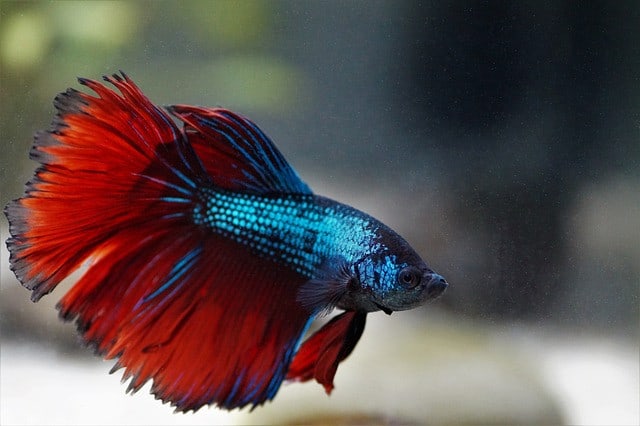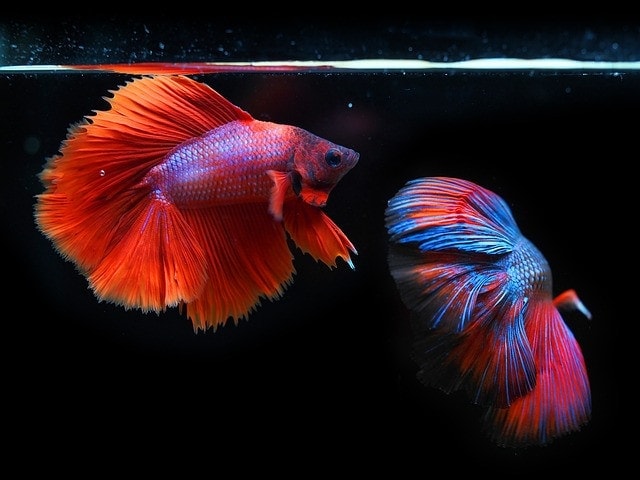How Many Betta Fish Can Live in a 5-Gallon Tank?
Betta fish, known as Siamese fighting fish, have long captivated aquarium enthusiasts with their vibrant colors and flowing fins. These exquisite creatures are famous for novice and experienced hobbyists due to their unique characteristics and relatively low maintenance requirements.
However, it is essential to provide suitable living conditions to ensure their well-being and longevity. This article will explore how many betta fish can comfortably coexist in a 5-gallon tank while meeting their specific needs.
Brief Overview of Betta Fish as Popular Aquarium Pets
Originating from the rice paddies of Southeast Asia, betta fish were first introduced to the aquarium trade in the late 19th century. Their striking appearance and intriguing behavior quickly made them beloved pets worldwide.

Betta fish come in various color variations, including vibrant reds, blues, purples, and metallic shades that shimmer under proper lighting. Beyond their beauty, bettas possess an array of fascinating attributes that make them ideal aquarium inhabitants.

They are labyrinth fish equipped with a specialized organ that allows them to breathe atmospheric air at the water’s surface. This adaptation enables bettas to survive in oxygen-deprived environments such as shallow pools or stagnant waters—a trait distinguishing them from other tropical fish species.
Importance of Providing Appropriate Living Conditions for Bettas
Creating a suitable environment is crucial for promoting any pet’s overall health and well-being—including betta fish.
While it may seem tempting to place these mesmerizing creatures in small bowls or tiny containers due to their ability to survive in oxygen-poor environments temporarily, it is vital for responsible owners to prioritize their welfare by providing ample space and proper care.
Inadequate tank sizes can lead to complications such as stunted growth, stress-related behaviors like fin biting, decreased lifespan, and increased susceptibility to diseases.
A betta fish’s long-term well-being depends on water temperature, pH levels, filtration, and adequate swimming space. Therefore, as caretakers, we are responsible for keeping betta fish to ensure they are housed in a suitable environment that mimics their natural habitat as closely as possible.
Focus on the Question: How Many Betta Fish Can Live in a 5-gallon Tank?
The understanding that bettas require appropriate living conditions to thrive leads us to ponder how many individuals can coexist harmoniously in a 5-gallon tank.
The size restrictions of such a small enclosure necessitate careful consideration to maintain optimal health and minimize aggression among tank mates. While larger tanks offer more flexibility regarding tank size, mates, and stocking levels, the restricted dimensions of a 5-gallon tank pose certain limitations.
Determining a suitable number of bettas for this particular setup requires understanding their territorial nature and specific spatial needs.
In the subsequent sections of this article, we will explore factors such as swimming space requirements and compatibility among multiple bettas or other potential tank mates in search of an answer to this intriguing question.
Understanding the needs of betta fish
Background information on bettas’ natural habitat in Southeast Asia
Betta fish, scientifically known as Betta splendens, originate from Southeast Asia’s shallow rice paddies and slow-moving waters. In these habitats, bettas tend to inhabit areas with dense vegetation and minimal water flow.
These conditions have shaped their unique characteristics and behavior, making them different from other tropical fish commonly kept in aquariums.
Bettas’ unique labyrinth organ and their need for access to air at the water’s surface
One remarkable feature that sets bettas apart is their labyrinth organ. This specialized breathing apparatus allows them to breathe atmospheric air to supplement oxygen intake from the water.
This adaptation in betta tanks enables them to survive in oxygen-depleted environments such as stagnant ponds or puddles. In aquariums, it’s crucial to provide betta fish with easy access to the water’s surface so they can take occasional breaths of air.
Discussion on the importance of maintaining proper water temperature, pH levels, and filtration
Maintaining appropriate water conditions is vital for betta fish’s overall health and well-being. Monitoring and regulating three key parameters are essential to ensure optimal living conditions: water temperature range, pH levels, and filtration.
Firstly, maintaining a stable water temperature between 76-82°F (24-28°C) is crucial for bettas since tropical fish require warm environments.
Fluctuations in temperature can cause stress or even lead to health issues. Secondly, monitoring pH levels is essential as it affects a betta’s ability to metabolize nutrients properly.
The ideal pH range for a betta fish tank should be slightly acidic, around 6.5-7.5. Providing adequate filtration helps maintain good water quality by removing toxins such as ammonia and nitrites that can harm betta fish.
A gentle or sponge filter is recommended to avoid excessive water flow that may stress bettas due to their delicate fins. Understanding the natural habitat of betta fish in Southeast Asia illuminates their unique needs.
Their labyrinth organ necessitates access to air at the water’s surface while maintaining appropriate water temperature, pH levels, and filtration is crucial for their overall well-being. By catering to these requirements, hobbyists can create a thriving environment for their beloved pet bettas.
Factors to Consider when Determining Stocking Levels in a 5-Gallon Tank
Tank Dimensions and Available Swimming Space for Each Fish
When determining how many betta fish can comfortably live in a 5-gallon tank, it is crucial to consider the tank’s dimensions and the swimming space available for each betta fish. A typical 5-gallon tank measures approximately 16 x 8 x 10 inches (L x W x H), providing limited spatial capacity.
Bettas are active swimmers and require ample space to explore their surroundings. It is recommended that each betta fish is provided with a minimum swimming space of at least one gallon to maintain their territorial nature and prevent stress-related health issues.
Compatibility among Multiple Bettas in a Confined Space
While it may be tempting to keep multiple bettas together in a single tank, it is essential to understand the compatibility challenges that arise when housing male bettas together.
Male bettas are known for their territorial and aggressive behavior towards one another, particularly when sharing limited territory. Keeping two male bettas in a five-gallon tank can escalate aggression as the confined space further intensifies their territorial instincts.
This can result in fin damage or even fatal injuries. Therefore, it is generally advised against housing more than one male betta in such a small tank.
Possibility of Keeping Male and Female Bettas Together
Considering the aggressive nature of male bettas towards each other, some aquarists may consider keeping a male and female betta together as an alternative option for stocking if betta fish require a five-gallon tank.
However, this approach also comes with potential complications. Introducing a female betta into the same tank as a male can trigger mating behaviors, which could lead to breeding complications if not adequately prepared for or desired.
Additionally, monitoring the interaction between a male and a female betta fish closely is vital, as some male bettas can become overly aggressive towards the female, causing stress or harm. Several factors must be considered when determining appropriate stocking levels in a 5-gallon tank for betta fish.
The tank’s dimensions and available swimming space per fish should meet their minimum requirements based on their territorial nature. Additionally, compatibility among multiple bettas in a confined space must be considered, as males tend to exhibit aggressive behavior towards each other.
While housing a male and female together might seem like an alternative option, potential breeding complications and aggression should also be carefully considered. Ultimately, providing the best living conditions for your betta fish is paramount to their health and well-being.
Options for Stocking a 5-gallon Tank with Betta Fish
Single Betta Setup: Advantages and Considerations
Keeping a single male or female betta in a 5-gallon tank is widely recommended due to their territorial nature. Bettas are known for their aggressive behavior towards each other, especially when sharing limited space. By providing a solitary environment, you can reduce the chances of aggression and create a stress-free habitat for your betta.
One of the critical benefits of housing a single betta is the reduced aggression that comes with it. Without competition from other fish, your betta can fully explore its surroundings without feeling threatened.
This ensures their emotional well-being and minimizes any risk of physical harm. Moreover, maintaining a tank with only one or two betta fish is generally easier to maintain and control water parameters.
With fewer inhabitants, monitoring water quality and ensuring optimal fish health conditions becomes simpler. Maintaining cleanliness also becomes more manageable as no other tank mates contribute to waste production.
Community Setup with Compatible Tankmates: Possibilities and Precautions
While keeping multiple bettas in the same tank isn’t advisable due to their territorial nature, it is possible to create a community setup by introducing compatible tank mates alongside one betta fish.
This approach allows good betta tank mates to enjoy more biodiversity within your 5-gallon tank while providing adequate space for each inhabitant.
When selecting suitable tank mates for your betta, consider peaceful species best tank mates that won’t provoke aggression or compete for resources. Some potential options include nerite snails, amano shrimp, otocinclus catfish, and mystery snails.
These species typically coexist peacefully with bettas as they inhabit different areas within the aquarium or have effective defense mechanisms. However, it’s crucial to exercise caution when introducing tank mates to your betta’s environment.
Ensure each creature has enough space and hiding spots to establish their territories and retreat if needed. Additionally, closely monitor the behavior of the tank mates and be prepared to remove any individuals that show signs of aggression or stress.
Conclusion
When considering how many betta fish can live in a 5-gallon tank, it is generally recommended to maintain a single betta setup due to their territorial nature. This approach provides several advantages, such as reduced aggression, easier maintenance, and better control over water parameters.
However, if you desire a more diverse aquarium, you can create a community setup with compatible betta tank mates while being mindful of maintaining ample space and suitable hiding spots for each inhabitant.
By carefully considering the needs of your betta and selecting appropriate tank mates, you can create a thriving aquatic ecosystem within your 5-gallon tank that brings joy and fascination to you and your fish.